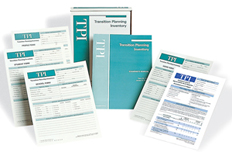
Complete Kit
Ages: 14 through 22 years
Testing Time: 15 to 30 minutes
Administration: Individual
TPI: Meeting the Requirements of NCLB and IDEA 2004
The Transition Planning Inventory (TPI) is an instrument for identifying and planning for the comprehensive transitional needs of students. It is designed to provide school personnel a systematic way to address critical transition planning areas that are mandated by the Individuals with Disabilities Education Act (IDEA) of 2004 and that take into account the individual student’s needs, preferences, interests, and strengths. Information on transition needs is gathered from the student, parents or guardians, and school personnel through the use of three separate forms designed specifically for each of the target groups. The TPI-UV includes four key components, each of which is described below:
Administration and Resource Guide:
This guide includes an overview of the instrument; background information on transition planning and assessment; detailed administration procedures; guidelines for interpreting and using the results of the TPI, including one extensive case study; and information regarding the technical features of the TPI. The guide also contains a blackline master of the planning notes form, the principal document used for moving from assessment to individualized planning. In addition, the guide includes an extensive list of over 600 transition goals that are correlated to each planning statement, blackline masters of the foreign language versions of the home form; and a comprehensive resource list.
Forms:
The TPI-UV contains four basic forms — Student Form: Home Form; School Form; and a Profile and Further Recommendations Form. The student, home, and school forms contain the same 46 items — the student and home forms are written at a lower readability than the school form. The student form also contains 15 open-ended questions that can be used to document efforts to base transition planning on the student’s interests and preferences. The profile provides a way to display the result obtained from the individual forms and to plan any further assessments that might be needed.
Informal Assessments for Transition Planning Book:
This resource contains over 600 more detailed statements and 45 informal assessments that are related to the 46 items on the TPI. It consists of three major components: (1) and introductory section on how to use the resource; (2) a “Comprehensive Informal Inventory of Knowledge and Skills for Transition;” and (3) selected informal assessments instruments related to major transition planning areas. The latter two components were designed to provide further assessment alternatives to complement or extend the information derived from the 46 items of the TPI.
Case Studies in Transition Planning Book:
This new component provides 15 comprehensive case studies, showing how to move from assessing transition needs to generating accurate present levels of functioning and appropriate transition goals – both instructional and linkage. The various cases cover a range of students with special needs for whom transition planning is required. Each case study includes TPI profile, planning notes form, furthers assessments (when appropriate), and a listing of present levels of performance and corresponding goals. This resource can serve as a guide for the development of valid, useful transition plans for students. The TPI-UV also includes the following new features that were added due to feedback provided by practitioners in the field.
The TPI can serve as the main vehicle for identifying transition needs or complement existing procedures. In some cases, it can serve as the framework for acquiring more detailed assessment information. The most important outcomes are to identify transition needs (knowledge, skills, supports, or services), regardless of methodology; develop necessary plans; and act on resultant goals. We recommend the following sequence of activities in using the TPI:
Complete TPI-UV Kit Includes (©2006):


